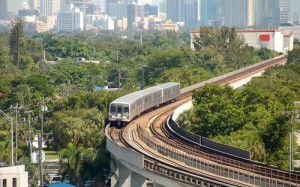
 Moving forward, some of the most exciting opportunities for public-private partnerships will be in the area of public transportation. Traditionally, public transportation systems have been constructed and operated solely with public dollars. Unfortunately, now that the need for new fast and efficient public transportation systems is greater than ever, those public dollars are hard to come by. Although the federal government has provided crucial funding to local transportation systems in recent years (Miami-Dade County’s planned acquisition of new rail cars for its Metrorail rapid rail system will likely be substantially funded by the FTA, for example), FTA funding alone is not going to be enough to get new transportation projects off the ground. Rather, the viability of the next generation of public transportation hinges on the availability of private capital.
Moving forward, some of the most exciting opportunities for public-private partnerships will be in the area of public transportation. Traditionally, public transportation systems have been constructed and operated solely with public dollars. Unfortunately, now that the need for new fast and efficient public transportation systems is greater than ever, those public dollars are hard to come by. Although the federal government has provided crucial funding to local transportation systems in recent years (Miami-Dade County’s planned acquisition of new rail cars for its Metrorail rapid rail system will likely be substantially funded by the FTA, for example), FTA funding alone is not going to be enough to get new transportation projects off the ground. Rather, the viability of the next generation of public transportation hinges on the availability of private capital.
MAP-21 Encourages P3s in Transportation Projects
A new federal transportation law, Moving Ahead for Progress in the 21st Century (MAP-21), which President Obama signed into law this summer, recognizes this reality. MAP-21 allocates over $10 billion per year for the next two years for public transportation. Those are big numbers, for sure, but what is far more significant is that MAP-21 expressly encourages the use of public-private partnerships in transportation projects, and the FTA is charged with developing guidance in the creation of P3 agreements. Clearly, PPPs will become an increasingly common element of public transportation projects.
P3 for Washington, D.C. Streetcar System
Local governments are catching on. Washington, D.C., for example, has recently issued a solicitation requesting ideas for the use of a P3 to fund its planned streetcar system. The PPP Bulletin reports that D.C. received 20 responses to its solicitation. That number is incredible (seven responses were received for D.C.’s recent, traditionally-funded acquisition of new rapid rail cars) and highlights the eagerness of both public agencies and private entities to enter into novel and productive P3s.
Public Transportation P3s in South Florida
Similar opportunities are, no doubt, on their way to South Florida. A private developer, Florida East Coast Industries, is planning a commuter rail line connecting Orlando and Miami. The new rail line will likely be funded by both private and public dollars, and has the potential to generate opportunities for spin-off P3s. For example, how will the new commuter rail interface with Miami’s existing public transportation systems, including Metrorail and Metromover? What local stations will be needed, and on whose property will they be built? Whatever the answers to these questions may be, they are likely to include some form of P3.